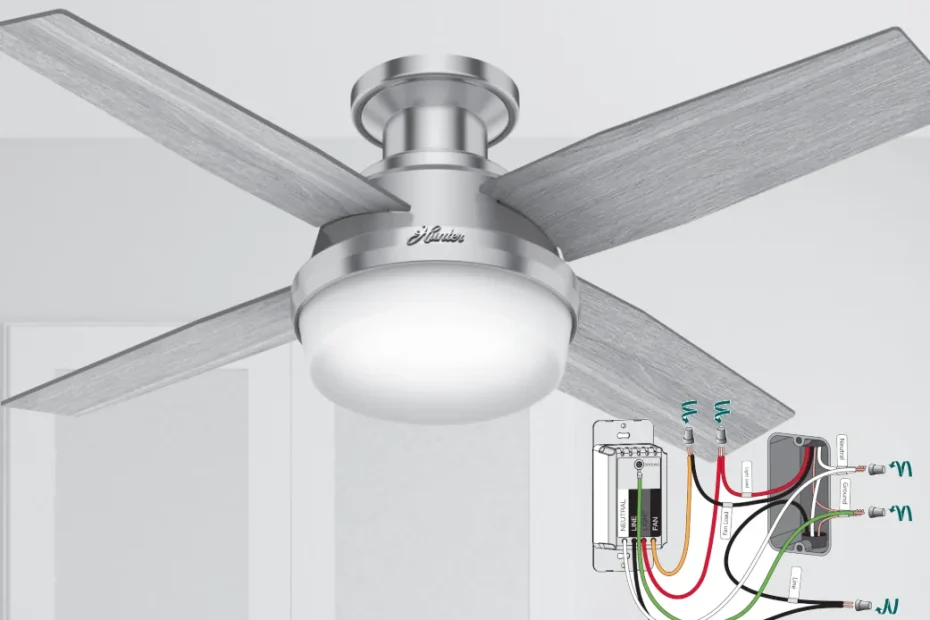Anebula is reader-supported. When you buy through links on our site, we may earn an affiliate commission.
My house gets hot in the summer, and while central air helps, it’s not enough. I needed to find a reliable ceiling fan and smart switch that would work well together and give me controls at the wall since wireless RF can be hit or miss.
Requirements for the fan:
- The ceiling fan needs to be dumb but not too dumb. In my research, I found that “Smart Ceiling Fans” always use proprietary wireless technology, which makes it difficult to integrate with and repair should it ever fail
- The ceiling fan needs to be high quality but not ridiculously expensive – in my research, Hunter fans were always favored for their high quality and reasonable pricing
- If the ceiling fan comes with wireless controls, then this feature should be removable so that I can hard-wire
- The ceiling fan motor should be AC (not DC) so that it can be controlled via a wall switch
Requirements for the wall switch:
- The wall switch needs to control fan speed and light dimming
- The wall switch needs to connect to the ceiling fan using standard 14/3 wiring so that the local control is 100% reliable
- The wall switch needs to be affordable
- The wall switch needs to connect to Home Assistant via Z-wave (see HA Docker Guide here)
Choosing a Ceiling Fan
This was by far the most time-consuming part since I needed to account for clearance, dimming capabilities, CFM, and the ability to remove the wireless receiver.
Ceiling Fan Size and CFM
I purchased two fans: a Hunter Avia II LED 52″ and a Hunter Dempsey Low Profile 44″, both of which went into 10×11-foot rooms. Some would consider the 52″ to be too big for that size room, but I’m happy with the result. Whenever possible, I try to upsize my equipment so that I can run things on low or have that extra power should I ever need it.
What to look out for when looking for a ceiling fan:
- Don’t look at the size (diameter) of the ceiling fan alone, also look for a high CFM. This varies greatly even within the same manufacturer due to design differences and motor selection. For example, the chart below shows that 52″ fan CFM ranges from 4225-5102 depending on the model, so choose wisely.
- You may need to check several websites to find CFM. Hunter’s official website did the best job of showing this information, however in some cases the fan wasn’t listed on the Hunter website so I needed to at vendor websites.
Light Dimming
If you need this feature, look for it in the ceiling fan specifications. Hunter fans, and in particular the ones that I bought, come with an additional wiring harness, which I believe smoothes out the dimming for an overall better experience. There’s a picture of this wiring harness at the bottom of the post. I will admit that I’m not an expert in this area, and I understand that it’s always the switch that does the dimming capability, so let me know if you know exactly what that harness is doing.
Wireless Remote/Receiver
This part is critical for the wall switch to control the fan correctly. You can set this up several ways but know that having the option to remove the receiver gives you more options and control.
Option 1: Use the remote + receiver and wire the fan to a regular double-pole switch. This option means that the wall switch is the master power on/off and that the remote is only effective if the wall switch is on. Optionally, you can direct-wire power to the ceiling fan and omit the wall switch entirely.
I didn’t go with this option because someone can turn off the power at the wall, rendering the remote useless until the wall switch is turned back on. Also, I don’t like relying on the RF remote, as the command doesn’t always reach the fan. Lastly, the remote can get lost and will also need new batteries from time to time.
Option 2: Remove the wireless receiver and control the ceiling fan and light at the wall. This is what I went with since I wanted that control at the wall because it’s the most fool-proof and reliable way to do it. For this, I had to run a new 14/3 with ground NMB cable from the switch to the fan so that the wall switch could control fan speed and light dimming.
If you want to do the same, you need to look for two things in your ceiling fan: #1. The wireless receiver is removable, and #2. The motor is AC-powered.
How do I know if the wireless receiver is removable? The easiest way is to check the installation manual for your fan and look for a diagram showing a wireless receiver. Here’s what they typically look like for Hunter. Notice the device looks like a separate component that can be omitted. Bingo! That’s what you want, so you can remove that and control it from the wall instead.
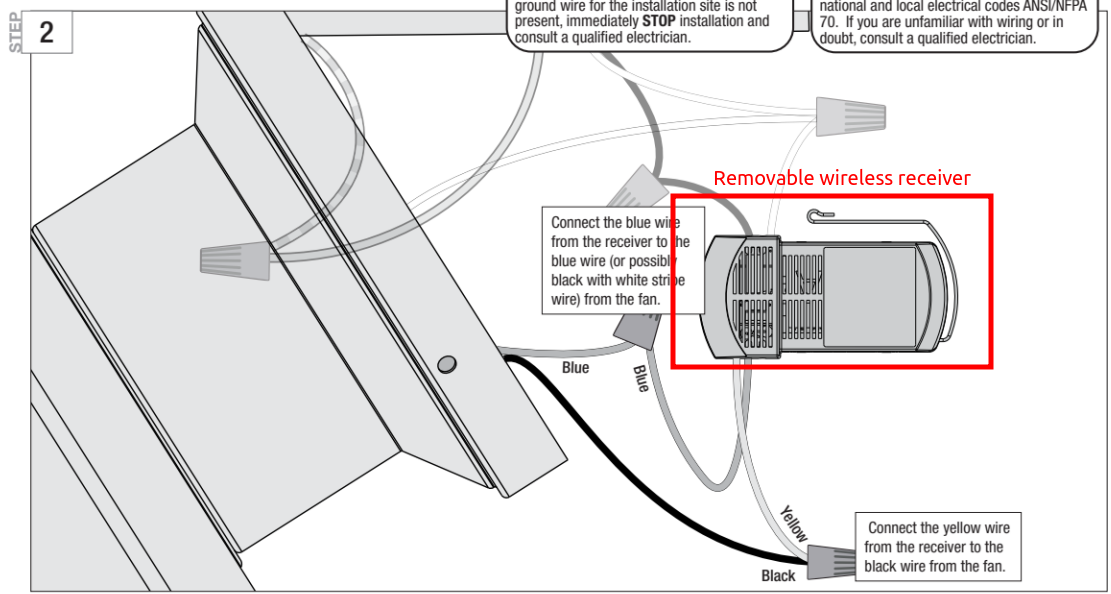
| Brand/Model | Size (inches) | CFM on High | Dimmable Lights | Can Remove Wireless Receiver | Motor |
|---|---|---|---|---|---|
| Hunter Avia II LED | 52 | 4225 | Yes | Yes | AC 153 x 15 |
| Hunter Mill Creek LED | 52 | 5035 | Yes | Yes | AC 153 x 20 |
| Hunter Apex LED | 52 | 4338 | Yes | Yes | AC 153 x 15 |
| Hunter Exeter LED | 54 | 3870 | Yes | Yes | AC |
| Hunter Dempsey Low Profile | 44 | 4010 | Yes | Yes | AC 172 x 12 |
| Hunter Gilmour Outdoor LED | 52 | 5102 | Yes | Yes | AC 153 x 18 |
I purchased two Hunter fans, Hunter Avia II LED and Hunter Dempsey Low Profile, and paired them with the TREATLIFE Smart Ceiling Fan Control and Dimmer Light Switch.
Choosing a Ceiling Fan Smart Switch
Unfortunately, there aren’t many options, and you’ll probably need to compromise. I wanted a switch that could control fan speed and light dimming, connect via Z-wave to my Home Assistant, and be affordable.
I chose the TREATLIFE Smart Ceiling Fan Control and Dimmer Light Switch, but I compromised on no Z-wave and no Home Assistant integration. It does, however, have an app that works great and can also integrate with Alexa, Google Home, and SmartThings, although I haven’t tried the integrations. I’m a big fan of Zooz and have purchased at least 10 switches and a few smart plugs in the last two years, so I wish they would upgrade their ZEN30 to support multiple fan speeds.
| Fan Switch | Price | Fan Speed Control | Light Dimming Control | Connectivity | Home Assistant Integration | Notes |
|---|---|---|---|---|---|---|
| TREATLIFE Smart Ceiling Fan Control and Dimmer Light Switch | $31 | Yes, 4-speed | Yes | Wi-Fi | No | Wi-Fi is unreliable and has no HA integration, but single gang implementation is appealing |
| Lutron Caseta Dimmer + no fan speed control | $96+ | None | Yes | Proprietary | Yes | Highest quality, but no solution for fan speed control |
| Zooz ZEN30 800LR Double Switch | $30 | On/off Only | Yes | Z-Wave | Yes | I wish Zooz could control fan speed with this switch because it would have been an easy choice for me |
| Kasa Smart Ceiling Fan Control & Dimmer Switch | $40 | Yes, 4-speed | Yes | Wi-Fi | No | Wi-Fi is unreliable and has no HA integration, but single-gang implementation is appealing |
Notable mentions of fan-only switches
- Leviton Decora Smart Fan Speed Controller, Z-Wave Plus, ZW4SF – This is compatible with Home Assistant
- Inovelli Blue Smart Fan Zigbee 3.0 Switch – This is also compatible with Home Assistant
Installation
This isn’t a how-to, but rather, it is how I installed the ceiling fans and switches for my specific setup. I have easy attic access, which makes the wiring relatively easy.
As a DIYer, I always review The Complete Guide to Wiring Updated 8th Edition before starting any electrical project. It has detailed diagrams showing common fan wiring setups and covers safety and electrical standards that should be met in the U.S. I highly recommend it.
My project began with installing a new ceiling fan brace. I purchased two different ones just to find the better one since I needed to install more ceiling fans after the first two. I purchased the Hubbell Raco 936 4 in. Round Retro-Brace Ceiling Fan-Rated Support and the Sealproof Fan Brace – Electrical Box and Support Bar for Ceiling Fans and Light Fixtures. After using both, I recommend the Hubbell Raco 936 over the Sealproof because it is beefier, and the design where the NMB cable enters is better thought out. Pictured here is the Hubbell Raco 936.

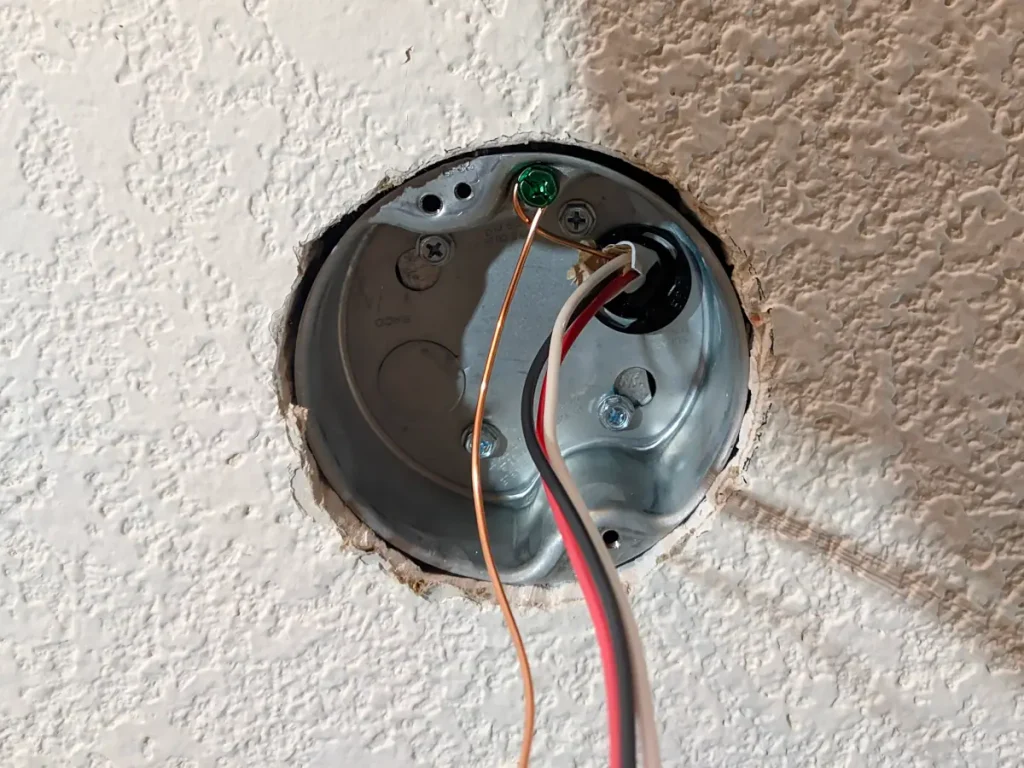
Here is a bottom-up close-up of the Hubbell Raco 936 fan brace support.
Not pictured here, but for the entire installation, I used Loctite Blue Threadlocker on every single bolt since I wanted to ensure everything was securely fastened and there was no chance the ceiling fan could fall on someone.
For thoroughness, here is the Sealproof Fan Brace—Electrical Box and Support Bar for Ceiling Fans and Light Fixtures that I used on one of the installations.
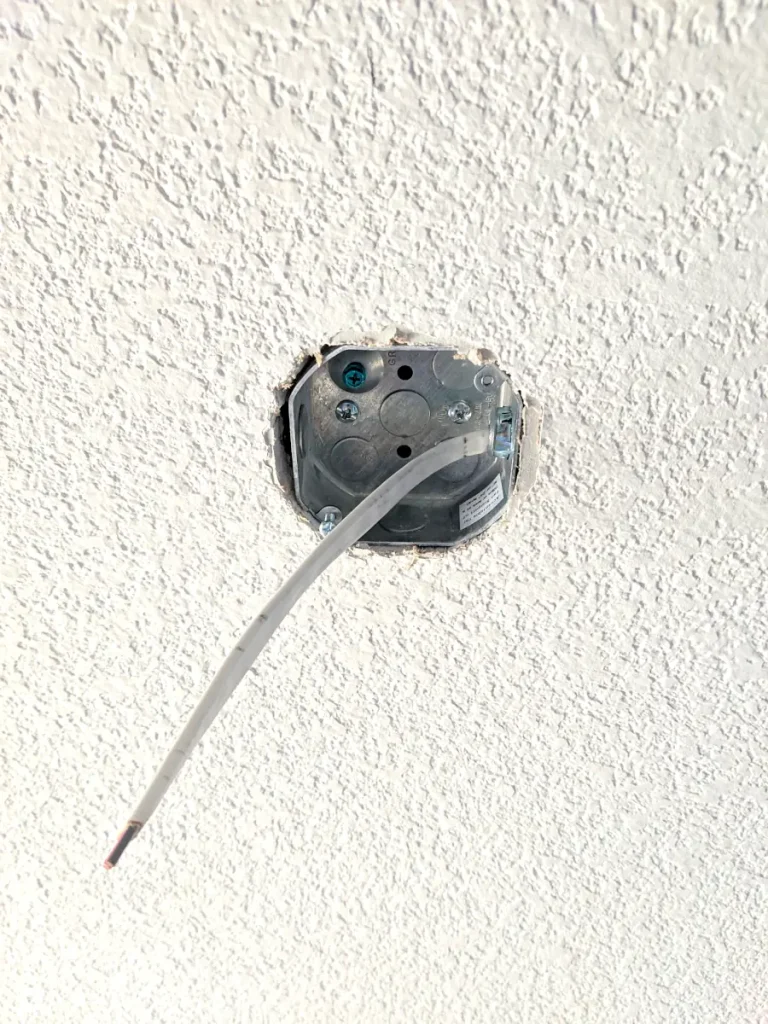

Also, above, you can see the new 14/3 with ground NMB cable that I ran. This was a new run from the ceiling fan down to the old switch.
This is important – I did not install the wireless receiver, so you can see here that my 14/3 wire goes directly into the fan.
- Neutral (white) goes to the white fan wire
- Light Load (red) goes to blue light wire
- Fan Load (black) goes to black fan wire
- Ground goes to the fan bracket and ceiling fan brace
Pictured here is the Hunter Dempsey Low Profile 44″ Ceiling Fan.
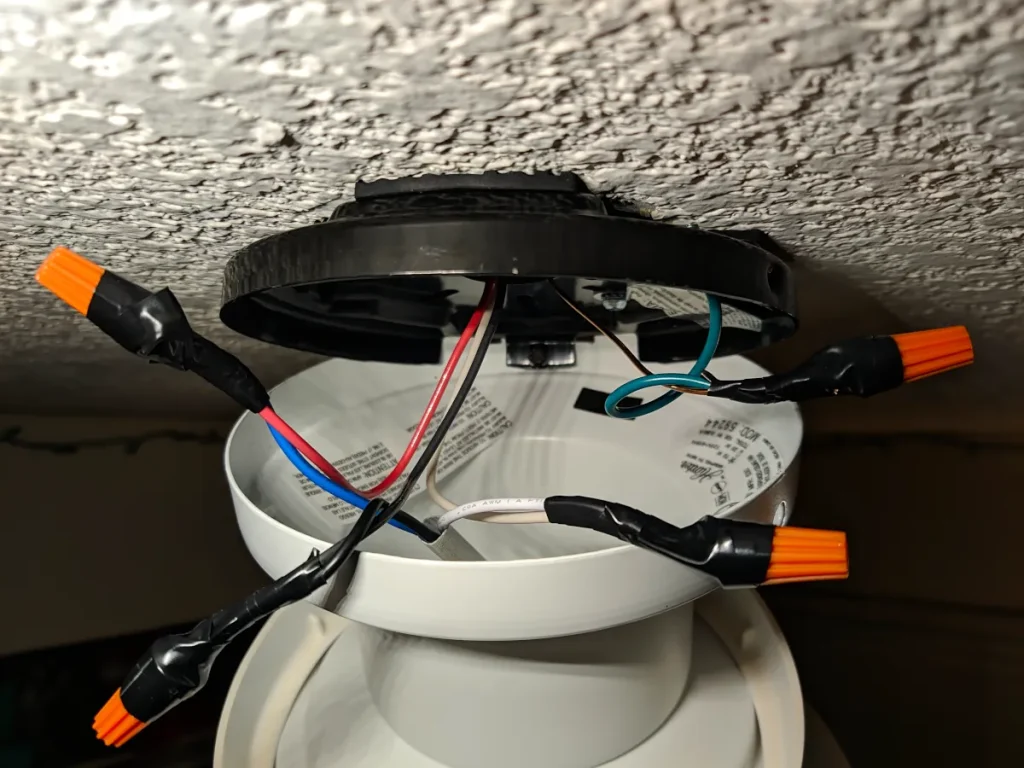

Here is the Hunter Avia II LED 52″ Ceiling Fan. The wiring at the fan and the switch was identical for both fan models.
This is a close-up of the Hunter Dempsey Low Profile 44″ Ceiling Fan light wiring harness. I’m not quite sure what this does, but I left it intact and connected everything here per Hunter’s instructions.
The dimming controls on the switch work perfectly and are buttery smooth, so I didn’t need to come back to this to modify it.
The other fan that I purchased had the same light-wiring harness setup.
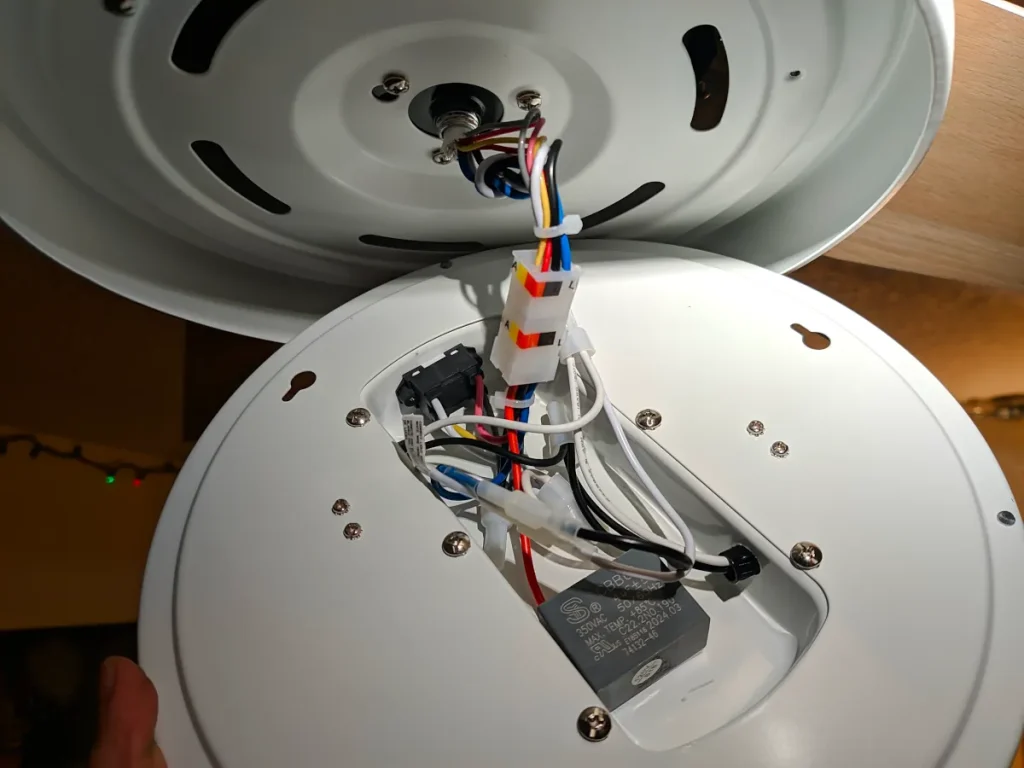
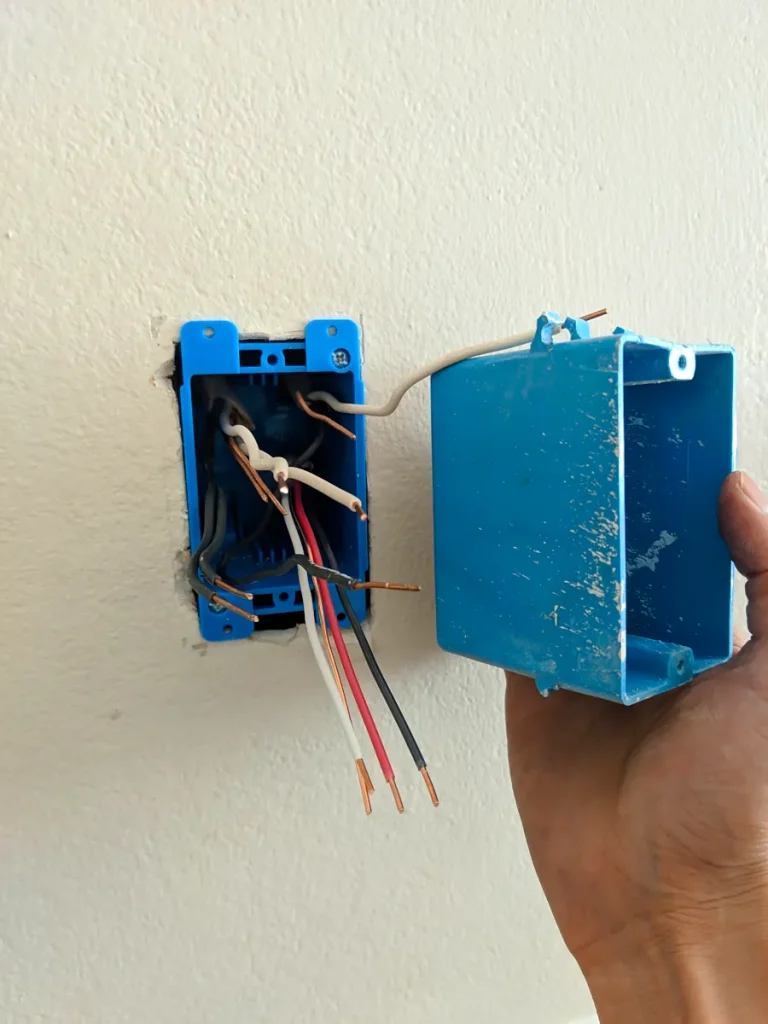
Smart switches are pretty big compared to old-school single-pole switches, so I upgraded the electrical box to a deeper one. The original one (shown in my hand) is 2.75 inches deep, while the new deeper one is 3.5 inches deep. Look for deeper ones with 20-25 cubic inches like these:
Home Depot – 1-Gang 24.5 cu. in. PVC New/Old Work Electrical Box
Amazon – LEONLITE Old Work Electrical Outlet Box One Gang, Ultra-deep 20 Cubic Inch Device Box
Removing the old box can be tricky. I wedged a flathead screwdriver between the box and the drywall to break the tabs off the nails, which gave me enough room to remove the old box.
For the wiring, I followed the instructions for the TREATLIFE Smart Ceiling Fan Control and Dimmer Light Switch.

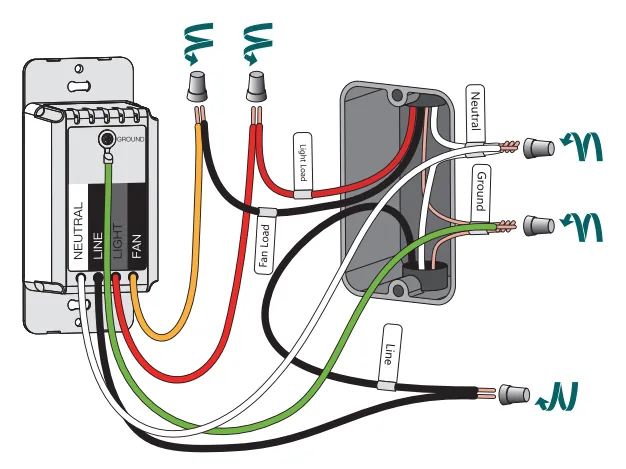
Here are the official instructions for the TREATLIFE DS03. For future reference, you should use the instructions that came with your switch in case the diagrams are updated
Here is the switch installed and powered. You can see that my drywall was damaged. This was okay with me since the rooms will get repainted in the near future.
One caveat of the switch is that it controls 4 fan speeds, and there is currently no way to limit it to 3 speeds. Therefore, you need to skip the lowest setting. For example, if you turn on the switch at the lowest setting, the fan auto shuts off, which is a little annoying. To work around this, you need to skip past the lowest fan speed and only use speeds 2-4.


Here is the final product installed.
And here is the other final product.

Thank you for reading! Let me know if you have any questions or comments by posting below.
No, to control fan speed, you need a dedicated switch that regulates the current specifically for ceiling fans. The TREATLIFE Smart Ceiling Fan Control and Dimmer Light Switch is a good switch for controlling fan speed and light dimming, all in one package.
You need a wall switch specifically designed to control fan speed. You also need to ensure your ceiling fan is AC powered so that the switch can control the fan speed via current flowing directly from the switch to the fan. The TREATLIFE Smart Ceiling Fan Control and Dimmer Light Switch is a switch capable of controlling fan speed.
